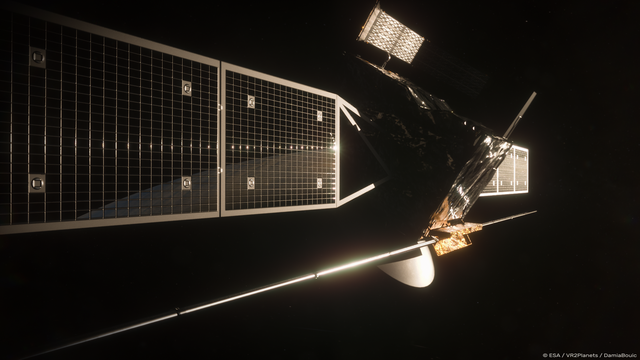Then There Were 3: NASA to Collaborate on ESA’s New Venus Mission
As a key partner in the mission, NASA provides the synthetic aperture radar, called VenSAR, to make high-resolution measurements of the planet’s surface features.
On June 10, 2021, the European Space Agency (ESA) announced the selection of EnVision as its newest medium-class science mission. EnVision will make detailed observations of Venus to understand its history and especially understand the connections between the atmosphere and geologic processes. As a key partner in the mission, NASA provides the synthetic aperture radar, called VenSAR, to make high-resolution measurements of the planet’s surface features.
With significantly higher resolution than that of NASA’s Magellan mission, which captured images of Venus in the early 1990s, VenSAR will improve our understanding of the planet’s surface features. Repeated observations and comparisons with Magellan imagery promise the opportunity for planetary scientists to detect volcanic, tectonic, and geomorphic changes over multiple timescales at a resolution that gets to the level of individual landslides. Scott Hensley of NASA’s Jet Propulsion Laboratory in Southern California is the instrument project scientist.
“EnVision’s VenSAR will provide a unique perspective with its targeted studies of the Venus surface, enriching the roadmap of Venus exploration,” said Adriana Ocampo, EnVision program scientist at NASA Headquarters in Washington.
In a “triple crown” moment for the Venus science community, the new mission to Venus comes at a time when NASA has just announced their upcoming DAVINCI+ (Deep Atmosphere Venus Investigation of Noble gases, Chemistry, and Imaging) and VERITAS (Venus Emissivity, Radio Science, InSAR, Topography, and Spectroscopy) missions. Working in concert, the trio of new spacecraft will provide the most comprehensive study of Venus ever.
“I am delighted that the synergistic capabilities of these three new missions will transform our fundamental understanding of Venus,” said Lori Glaze, director of NASA’s Planetary Science Division at the agency’s headquarters. “ESA’s EnVision mission will provide unparalleled high-resolution imaging and polarimetry capabilities. High-resolution images of many dynamic processes at Mars profoundly changed the way we thought about the Red Planet and images at similar scales have the potential to do the same for Venus.”
The new observations can also tell us about Venus’ evolution. “The combined results of EnVision and our Discovery missions will tell us how the forces of volcanism, tectonics and chemical weathering joined together to create and sustain Venus’ runaway hothouse climate,” said Tom Wagner, NASA’s Discovery Program scientist at NASA Headquarters.
Of the three missions, the DAVINCI+ atmospheric entry probe can provide the only direct measurements of the Venus atmosphere – for the first time since NASA’s Pioneer Venus probe in 1978 and the USSR's Vega balloons in 1985. Many of the proposed measurements are of highest decadal priority and can only be acquired by traveling directly through the planet’s harsh atmosphere.
The global topography data generated by VERITAS is also a unique contribution among the three missions. It will provide scientists with high-resolution topography and a global location map for Venus that will serve as a reference system for all past and future surface data collected.
NASA is a partner with ESA on the EnVision mission. JPL, a division of Caltech in Pasadena, California, will provide the VenSAR radar and will have responsibility of the overall instrument management and provision. EnVision VenSAR is part of NASA’s Discovery Program. And, NASA’s Marshall Space Flight Center in Huntsville, Alabama, manages the Discovery Program for the agency’s Science Mission Directorate in Washington, D.C.
For more information about NASA’s planetary science, visit:
https://www.nasa.gov/solarsystem
For more information about ESA’s Cosmic Vision plan, visit:
https://sci.esa.int/web/cosmic-vision/-/46510-cosmic-vision
#sri_lankan_space_agency




No comments:
Post a Comment